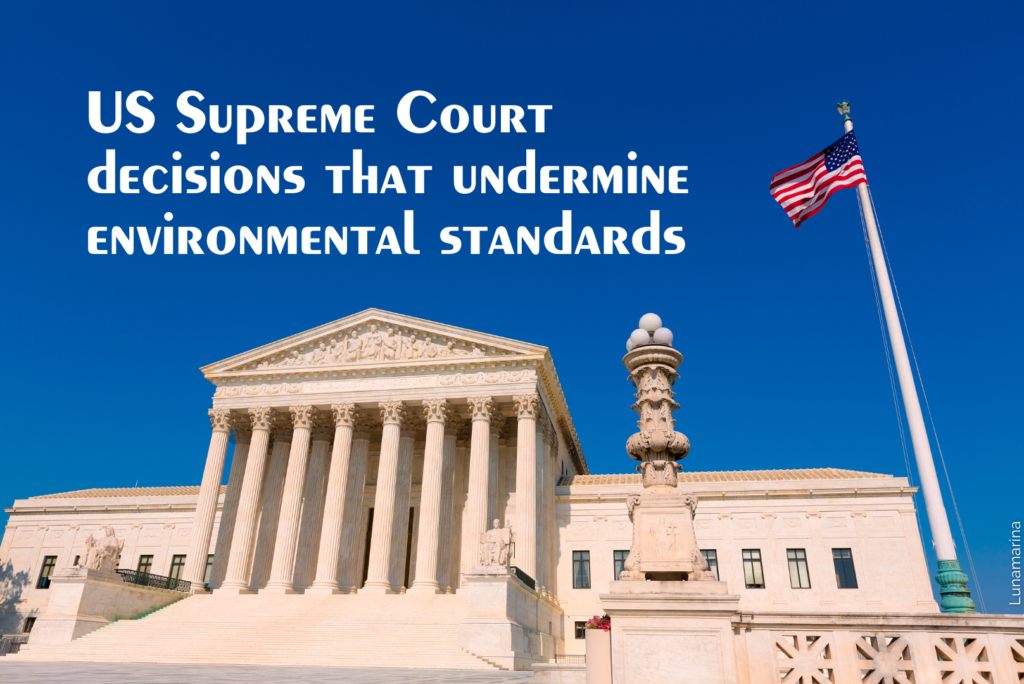Recent decisions by the overwhelmingly conservative majority in the US Supreme Court in the area of environmental law signal about a danger to environmental protection.
Several recent decisions reflect the attitude of the modern US Supreme Court to environmental legislation. In “West Virginia v. EPA” case adopted in June 2022, the US Supreme Court canceled the “Clean Power Plan” adopted during the presidency of Barack Obama (hereinafter – CPP). The CPP was intended to reduce carbon dioxide emissions from power plants by forcing them to shift to renewable energy sources. The US Supreme Court ruled that the Environmental Protection Agency (the EPA) could not exercise its authority to control emissions into the atmosphere under the CPP because the Clean Air Act allows the EPA to establish pollution control only the territory of economic units.
After that in “Sackett v. EPA” case, resolved in May 2023, the US Supreme Court ruled that the EPA could not require an Idaho couple to obtain a permit before backfilling their own perennial ponds on their land. In this decision, the US Supreme Court overturned previous decisions, finding that the language of the Clean Water Act does not extend to protect water bodies if they are “virtually indistinguishable” from surface water and are located on private property.
U.S. law experts point out that the authors of major laws such as the Clean Air Act and the Clean Water Act used broad rhetoric to describe ambitious environmental goals and then gave agencies broad powers to achieve them. The visionaries who wrote and passed these laws knew that legislators could not cover every detail and that scientists, not politicians, should identify and solve new problems as they arise. Environmental protection in the US is therefore based on the understanding, established since the days of Roosevelt’s New Deal, that Congress has strong regulatory power and that Congress can delegate that power broadly to expert agencies such as the EPA.
The cases of Sackett and West Virginia v. EPA undermine these assumptions. In both cases, the US Supreme Court expressed a different opinion about the scope of Congress’s power to regulate an activity and the extent to which Congress can delegate that power to federal agencies. In both cases, conservatives on the US Supreme Court tried to say that federal environmental regulations are among the worst examples of “big government gone mad.”
The philosophy of conservative judges appears to be the result of a campaign by polluting industries. Big business in these industries has spent years and millions of dollars lobbying the Congress to change fundamental environmental laws and demanding that presidents liquidate agencies like the EPA. These efforts have largely failed because Americans want elected officials to protect the environment. Therefore, industries, mainly the oil and gas industry, turned to the support of conservative and anti-government legal opinions among judges.
The cases of Sackett and West Virginia v. EPA are part of a broader campaign to influence the federal government in ways that limit its ability to exercise its powers in the interests of the general public. The US Supreme Court has cast skepticism on federal regulatory authority not only in the environmental context, but also in recent cases dealing with vaccination requirements for COVID-19. This year, the US Supreme Court overturned President Biden’s decision to cancel certain student loans applying the conclusions it formed in West Virginia v. EPA.
Thus, recent decisions of the US Supreme Court regarding environmental law pose serious threats to environmental protection. The decisions in “West Virginia v. EPA” and “Sackett v. EPA” indicate to the formation of views of the judges of the US Supreme Court aimed at limiting the powers of federal agencies in determining and enforcing environmental standards.


